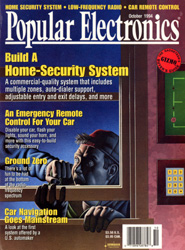

Popular
Electronics
October 1994


Small Wonder
FM SOUNDS MINIATURE FM RADIO.
Manufactured by American Technology
Corporation, 12800 Brookprinter Place,
Poway, CA 92064; Tel: 619-679-2114.
Price: $29.95.When we heard the claim that the world's smallest FM radio had been introduced by American Technologies Corporation, we had to get our hands on the FM Sounds. We have always loved the miniaturization that electronics has made possible.
It sounded too good to be true: digital touch tuning in an FM receiver that weighed less than a quarter of an ounce and was designed to be worn in the car! We couldn't wait to try it.
The unit arrived in a protective carrying case that stored the receiver, two batteries, an ear clip, and two antennas. The batteries are two 1.5 volt type-392 button cells. The ear clip, which is removable, helps to hold the receiver snugly in the ear even when you are walking or jogging. Without the ear clip, the receiver has an annoying tendency to fall out of the ear if you move around too quickly.
Two antennas are supplied with the receiver. The first is a stiff piece of wire about four inches long. The second is a flexible wire that is about 27 inches long. Since the short antenna was installed when we received the unit, and because it seemed most convenient, we powered up the radio and gave a listen.
The power switch is also the radio's volume control. It's not continuously variable as most volume controls are. Instead, it has only two positions, low and high. We weren't too happy about that, but we figured that we had to trade off something to get such a small radio.
Only two other controls are located on the FM Sounds: SCAN and RESET membrane-type buttons. A push of the SCAN button causes the radio to automatically scan up in frequency until a station of adequate strength is found. The RESET button returns the receiver to the bottom of the FM band. When the top of the band is reached, the RESET button must be pushed to return to the bottom of the band. That's not really an inconvenience. On the contrary, because there is no display, it actually helps you to keep track of where you are tuning.
When we first powered up the radio, we hit the RESET button, and then SCAN. Nothing. Another rip-off! We changed our position slightly and tried again. This time we received one station, a local broadcaster. Needless to say, our opinion didn't change much.
We were so disappointed by the results that we weren't even going to bother to connect the second antenna. When we did, however, we were pleasantly surprised to be receiving stations. Reception was actually quite good - better, in fact, than what was provided by many of the personal stereos that we've tried!
We do have our complaints about the receiver, however, and we would probably be willing to put up with an increase in size to fix the problems. The most troublesome aspect of the receiver is that it is very frustrating to use when you are walking. If you lose a signal momentarily, the radio will scan up in frequency. Then you have to start all over again trying to find it. Our second complaint is that the buttons are not easy enough to press -- our ear was hurting after just a short listening time! We would have preferred actual pushbuttons instead of the membrane switches used by the unit.
We would also like to have a manual-tune mode along with the auto-scan mode. And we would like the option of hearing the radio while it scans. As is, it mutes automatically.
The FM Sounds is impressive because of its size. It doesn't really strike us as a very practical receiver, but it is fun. In some instances, however, it can be practical. We used it, for example, in conjunction with a low-power FM transmitter to listen to TV audio as we moved around the house on a Saturday afternoon. Because the transmitter had adequate signal strength, we never lost the signal. The receiver is light enough that it was a very comfortable way to listen.
American Technology Corporation is reportedly expected to introduce a product called Wireless Sounds that bundles such a transmitter with the receiver. Perhaps they should start work on laptop computers -- we still haven't found one small and light enough for our tastes.


Contact Webmaster
Copyright © 2001-2005 Woody Norris. All rights
reserved.
Revised: September 29, 2005